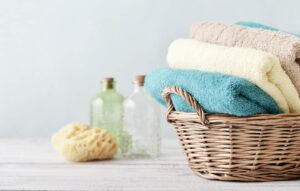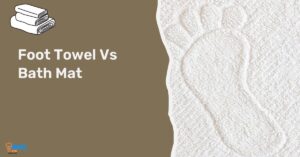Can You Wash Tea Towels With Bath Towels? Yes!
Yes, you can wash tea towels with bath towels. However, for hygiene purposes, it’s recommended to wash them separately.
Tea towels, being used in the kitchen, might be covered in food residue or bacteria. Bath towels can carry body oils and dead skin cells.
When washed together, there can be a cross-contamination between these two types of towels. For best cleaning results and to maintain hygiene, it is advised to wash these towels separately.
Remember, cleanliness is next to godliness. When it comes to towels, this principle applies too. Tea towels and bath towels have different uses and thus, may carry different types of residues or bacteria.
Washing them separately avoids the risk of cross-contamination, ensuring your tea towels are food-safe and your bath towels are skin-friendly.

Key Takeaway
The Difference Between Tea Towels And Bath Towels
Tea towels and bath towels serve different purposes and have different sizes. While they can be washed together, it’s important to separate them to avoid cross-contamination and ensure proper cleaning.
Tea Towels: Purpose, Material, And Usage
Tea towels are a versatile tool in any kitchen, serving a range of purposes. Whether you need them for drying dishes, cleaning countertops, or handling hot pots and pans, tea towels are the go-to option.
Made from lightweight and highly absorbent materials, such as cotton or linen, they are designed to efficiently soak up moisture. Tea towels are also known for their vibrant colors and patterns, adding a touch of style to your kitchen décor.
Let’s dive deeper into the purpose, material, and usage of tea towels:
Purpose of tea towels:
- Drying dishes: Tea towels excel at absorbing water, making them ideal for drying dishes and glassware efficiently.
- Cleaning surfaces: With their absorbent nature, tea towels are excellent for wiping down countertops, tables, and other kitchen surfaces.
- Handling hot items: Tea towels provide a protective barrier when handling hot pots, pans, and baking sheets, preventing burns.
Material of tea towels:
- Cotton: The most common material used for tea towels is cotton, known for its absorbency and durability. It is soft, lightweight, and easy to clean, making it ideal for everyday use.
- Linen: Linen tea towels are highly absorbent and lint-free. They are strong and long-lasting, making them a popular choice among professionals.
Usage of tea towels:
- Cooking and baking: Tea towels are perfect for covering dough while it rises or keeping baked goods warm after they come out of the oven.
- Table setting: Tea towels can double as stylish table napkins or placemats, adding a touch of elegance to your dining experience.
- Gift wrapping: With their attractive patterns and colors, tea towels can be creatively folded and used as unique gift wrap or even as part of the gift itself.
Bath Towels: Purpose, Material, And Usage
Bath towels are an essential part of our daily routines, providing comfort and functionality after bathing or showering.
Whether you need to dry off, wrap yourself up, or add a touch of luxury to your bathroom, bath towels have got you covered.
Let’s explore the purpose, material, and usage of bath towels:
Purpose of bath towels:
- Drying off: Bath towels are specifically designed to absorb moisture from your skin, providing a quick and efficient drying experience.
- Wrapping up: After bathing, bath towels envelop you in warmth and coziness, ensuring you stay comfortable while you get dressed.
- Enhancing bathroom decor: Bath towels come in a wide range of colors, patterns, and textures, allowing you to express your personal style and add a decorative touch to your bathroom.
Material of bath towels:
- Cotton: Cotton bath towels are known for their softness, absorbency, and durability. They are gentle on the skin and retain their quality even after frequent washing.
- Microfiber: Microfiber bath towels are made from synthetic fibers that are highly absorbent and quick-drying. They are often used for their lightweight and compact properties, ideal for travel.
Usage of bath towels:
- Everyday use: Bath towels are a staple in every bathroom, used by individuals and families alike for their daily bathing rituals.
- Beach or pool: Bath towels can double as beach or pool towels, providing a comfortable surface for lounging or drying off after a swim.
- Gym or sports activities: Lightweight bath towels are often preferred for sports or gym activities, as they are easy to carry and quick to dry.
Tea towels and bath towels serve distinct purposes in different areas of our lives. While tea towels dominate the kitchen scene, assisting with drying, cleaning, and handling hot items, bath towels are essential for personal care, offering comfort, absorption, and a touch of luxury.
Now that we understand the differences between tea towels and bath towels, we can explore the question of whether they can be washed together. Stay tuned for our next section to find out more!
The Importance Of Separating Tea Towels And Bath Towels
Separating tea towels from bath towels is important to maintain hygiene in your home. Wash them separately to avoid cross-contamination and ensure optimum cleanliness for both items.
When it comes to doing laundry, we often toss all our dirty towels together without giving it a second thought.
However, it’s important to understand the potential risks of washing tea towels and bath towels together.
We will explore the hygiene considerations and cross-contamination risks associated with mixing these two types of towels.
Hygiene Considerations:
- Tea towels are used primarily for drying dishes and handling food in the kitchen, which means they can easily accumulate bacteria and food particles.
- Bath towels are used for drying our bodies after bathing. They can collect dead skin cells, body oils, and other bodily fluids.
To maintain proper hygiene, it is crucial to separate these towels while washing.
Cross-Contamination Risks:
- Mixing tea towels and bath towels in the same load increases the chances of cross-contamination between the kitchen and the bathroom.
- Bacteria from the kitchen that may be present on tea towels can transfer to bath towels during washing, potentially increasing the risk of infections or illnesses.
By washing these towels separately, you can minimize the cross-contamination risks and ensure the cleanliness of your towels.
Remember, good hygiene practices play an essential role in keeping our living spaces clean and preventing the spread of harmful bacteria.
Take the extra step to separate your tea towels and bath towels when doing laundry to promote optimal hygiene in your home.
Factors To Consider Before Washing Tea Towels With Bath Towels
Before washing tea towels with bath towels, consider factors like color bleeding and fabric quality. Ensure colorfastness and check for any potential damage or excessive lint before mixing different types of towels in the same load.
When it comes to laundry, it can be tempting to throw all your towels together and save time and effort. But before you toss your tea towels in with your bath towels, there are a few factors to consider.
From shared washing machine usage to the types of fabrics and colors involved, here’s what you need to know before washing tea towels with bath towels.
Shared Washing Machine Usage:
- Avoid washing tea towels with bath towels if they have been used in the kitchen to clean up spills, grease, or other food-related messes.
- The bacteria, oils, and residue from the kitchen can transfer to your bath towels and affect their cleanliness and freshness.
- If you use your tea towels exclusively for drying dishes and other kitchen-related tasks, they can typically be washed with bath towels.
- However, it’s a good idea to shake or brush off any loose debris before washing to prevent it from transferring to your bath towels.
- Sharing a washing machine with others, especially if they have different laundry habits, can impact your decision to wash tea towels with bath towels.
If you’re unsure about the cleanliness of their laundry or if they frequently wash heavily soiled items, it’s best to err on the side of caution and separate your tea towels from your bath towels.
Types Of Fabrics And Colors:
- Consider the fabric type and care instructions for your tea towels and bath towels. Cotton is a common fabric used for both types of towels, making it easier to wash them together.
- However, fabrics like microfiber or delicate materials may require separate washing to maintain their quality and absorbency.
- Pay attention to the colors of your tea towels and bath towels. If there is a significant difference in color, especially if the tea towels are new or highly pigmented, it’s wise to wash them separately to prevent color bleeding.
- Mixing lighter and darker colored towels may result in dingy-looking or discolored bath towels. If your tea towels have decorative elements like embroidery or appliques, it’s best to wash them separately from your bath towels to avoid potential damage.
- These delicate embellishments can get snagged or pulled during the washing process if they come into contact with other towels or clothing items.
While washing tea towels with bath towels can save time and energy, it’s important to consider shared washing machine usage and the types of fabrics and colors involved.
Separating heavily soiled kitchen tea towels and taking care to wash delicate or differently colored towels separately will help preserve the cleanliness and quality of your bath towels.
By being mindful of these factors, you can ensure that your laundry routine remains efficient and your towels stay fresh and functional.
Pros and Cons of Washing Tea Towels with Bath Towels
Pros of Washing Tea Towels with Bath Towels:
- Convenience: Washing tea towels with bath towels is convenient, as it allows for efficient laundry management without the need for separate loads.
- Water and Energy Efficiency: Combining different types of towels can optimize water and energy usage by maximizing the washing machine’s capacity.
- Time-Saving: Washing tea towels and bath towels together can save time, streamlining the laundry process and reducing the number of individual loads.
- Color Coordination: When washed together, towels of similar colors can maintain a coordinated aesthetic, enhancing the overall appearance of the linen closet.
Cons of Washing Tea Towels with Bath Towels:
- Fabric Compatibility Issues: Different fabric types may have varied care requirements, potentially leading to wear and tear or reduced lifespan if not handled appropriately.
- Color Bleeding Risks: Mixing towels of diverse colors may pose a risk of color bleeding, potentially causing discoloration and affecting the appearance of the towels.
- Hygiene Concerns: Bath towels, which are often used for personal hygiene, may transfer bacteria or contaminants to tea towels during washing, impacting their designated use in the kitchen.
- Absorbency and Softness Impact: Washing towels together may affect the absorbency and softness of tea towels, especially if bath towels release fibers that cling to the kitchen towels.
It’s essential to weigh these pros and cons based on individual preferences and laundry habits to determine the most suitable approach for washing tea towels with bath towels.
Best Practices For Washing Tea Towels With Bath Towels
Tea towels and bath towels can be washed together, following these best practices. Use a gentle detergent, separate colors, wash in warm water, and avoid fabric softeners. Hang to dry or use a low heat setting in the dryer for optimal results.
When it comes to doing laundry, it’s important to sort your clothes based on fabric type to avoid any mishaps.
This is especially true when washing tea towels and bath towels together. Tea towels, commonly made of cotton or linen, are often used for drying dishes and hands.
Bath towels are typically made of thicker material to provide better absorbency after bathing.
To ensure that both types of towels are properly cleaned and maintained, follow these best practices:
Sorting Laundry Based On Fabric Type
To prevent unwanted damage or lint transfer, it’s crucial to sort laundry based on fabric type before washing.
When washing tea towels with bath towels, consider the following:
- Sort tea towels and bath towels into separate loads: Washing similar fabrics together allows for more effective cleaning and helps preserve the quality of each towel.
- Group tea towels with other lightweight items: Since tea towels are typically thinner and more delicate than bath towels, it’s best to wash them with similar items like hand towels or cloth napkins.
- Separate heavily soiled items: If your tea towels have stains or are heavily soiled, it’s advisable to wash them separately to prevent any dirt or grime from transferring to your bath towels.
Using Proper Detergent And Washing Settings
Using the right detergent and washing settings is essential to ensure that your tea towels and bath towels are thoroughly cleaned.
Follow these tips:
- Choose a gentle detergent: Opt for a mild detergent to prevent damage to the fibers of your tea towels and bath towels.
- Avoid fabric softeners: Fabric softeners can impact the absorbency of your towels, so it’s best to skip them.
- Use a warm water setting: Warm water helps to remove dirt and oils effectively, ensuring your towels are clean and fresh. However, remember to check the care labels on your towels for specific temperature recommendations.
By following these best practices, you can keep your tea towels and bath towels clean, fresh, and in excellent condition.
Proper sorting, careful detergent selection, and appropriate washing settings are key to maintaining the quality and functionality of your towels.
Happy laundering!
Tips For Maintaining Tea Towels And Bath Towels Fresh And Clean
Maintain the freshness of your tea towels and bath towels by washing them separately to avoid cross-contamination. This simple step will ensure that both are kept clean and hygienic for everyday use.
Tea towels and bath towels are essential items in every household, serving different purposes. While it may be tempting to wash them together, it’s crucial to consider a few factors to keep them fresh and clean.
We will explore proper drying techniques as well as the frequency of washing and replacement for tea towels and bath towels.
Proper Drying Techniques:
- Hang them properly: After washing, make sure to hang both tea towels and bath towels in a well-ventilated area to dry. Avoid folding them immediately, as this can lead to a damp environment and an unpleasant odor.
- Sunlight is key: Whenever possible, take advantage of natural sunlight to dry your towels. The UV rays help to eliminate bacteria and freshen them up.
- Avoid overcrowding: Ensure that the towels are not packed tightly together while drying, as this can extend the drying time and affect their freshness.
- Fluff them up: Give your towels a good shake before hanging them out to dry. This will help remove any remaining moisture and keep them soft and fluffy.
Frequency Of Washing And Replacement:
- Tea towels: Given their frequent use and exposure to food particles, tea towels should be washed every two to three days, or even more frequently if necessary. Replace them every six to twelve months or when they become heavily stained or worn out.
- Bath towels: Bath towels should ideally be washed after every three to four uses, depending on personal preference and hygiene standards. Replace them every one to two years or when they start to lose their absorbency or develop a musty smell.
Proper care and maintenance of tea towels and bath towels will not only prolong their lifespan but also ensure that they remain fresh and hygienic for everyday use. By following these simple tips, you can enhance the cleanliness and durability of your towels.
So, let’s make a habit of keeping our tea towels and bath towels in their best condition for a comfortable and refreshing experience.
Alternative Solutions To Washing Tea Towels With Bath Towels
Tea towels and bath towels have different fabric compositions and absorbency levels, so it is not recommended to wash them together.
Instead, consider alternatives like washing tea towels separately, using a mesh laundry bag, or hand washing them to maintain their quality and cleanliness.
Who knew that something as simple as washing towels could cause so much confusion? If you’re questioning whether it’s safe or practical to wash tea towels with bath towels, you’re not alone.
Fortunately, there are alternative solutions that can help you keep your laundry organized and hygienic.
Let’s explore these options below:
Separating Towels By Usage
When it comes to maintaining cleanliness and hygiene, one effective solution is to separate your towels based on usage. This means keeping tea towels separate from bath towels.
Here’s how you can do it:
- Designate specific towels for each purpose: Assign different colored towels for different uses. For example, use white towels for bath towels and colored towels for tea towels. This will make it easy to recognize and separate them during laundry.
- Establish clear guidelines: Inform your family members or roommates about the importance of separating towels by usage. Encourage everyone to follow these guidelines to ensure clean and germ-free towels.
Using Color-Coded Towels
Color-coding towels is a visually appealing and practical way to differentiate between different types of towels.
Here are some tips to help you implement this method:
- Assign a specific color to each towel category: Choose a color scheme that works for you and stick to it. For instance, use blue towels for bath towels and green towels for tea towels.
- Label or tag your towels: To avoid any confusion, you can attach small tags or labels to your towels indicating their designated use. This will make it easier for everyone in your household to identify and separate the towels correctly.
By implementing these alternative solutions, you can keep your tea towels and bath towels separate, ensuring a more organized and hygienic laundry routine.
So, say goodbye to the question of whether you can wash tea towels with bath towels, and embrace a more efficient way of laundering your towels.
Remember, keeping a clear distinction between tea towels and bath towels not only contributes to better hygiene but also helps extend the lifespan of your towels. Implement these simple solutions and enjoy the benefits of a well-organized laundry routine.
Conclusion
It is perfectly fine to wash tea towels with bath towels as long as they are of similar fabrics and colors. Mixing these items together in a single load can save time and energy, making the laundry process more efficient.
However, it is important to consider the level of dirt or stains on the towels. If the tea towels are heavily soiled or have absorbed strong odors, it is best to wash them separately to prevent cross-contamination.
Furthermore, using the appropriate detergent and following the care instructions on the labels will help maintain the quality and lifespan of both tea towels and bath towels.
By practicing proper laundry habits and considering the condition of the towels, you can keep them fresh, clean, and ready for their respective purposes.






